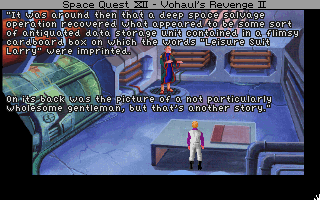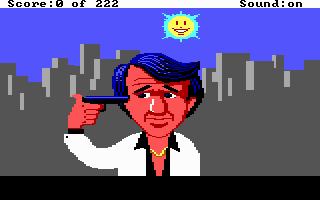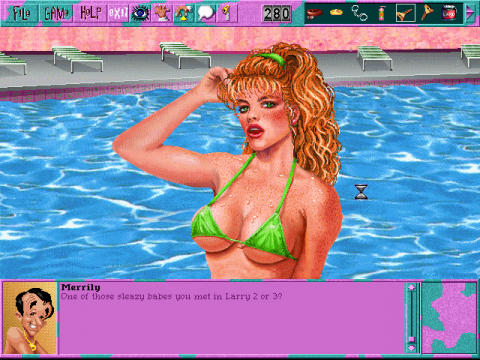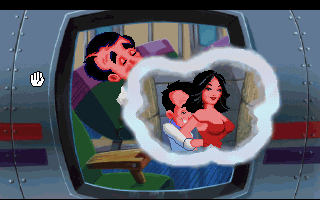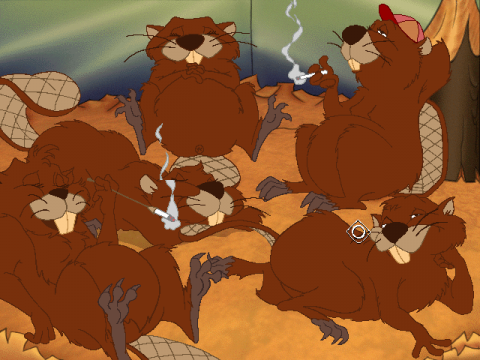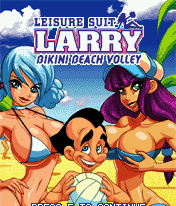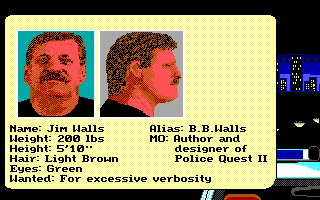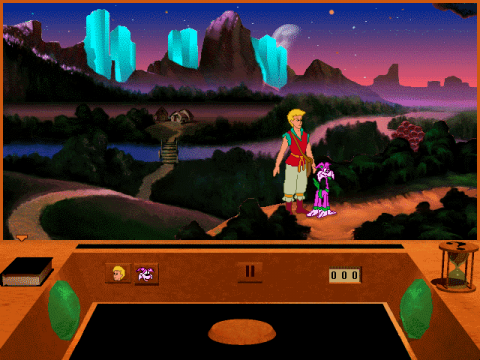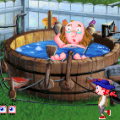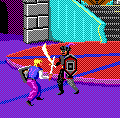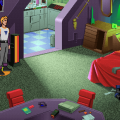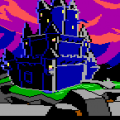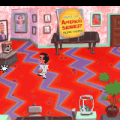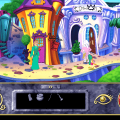- Leisure Suit Larry (Introduction)
- Al Lowe (Interview)
- Softporn Adventure / Las Vegas
- Leisure Suit Larry in the Land of the Lounge Lizards
- Leisure Suit Larry Goes Looking for Love (in Several Wrong Places)
- Leisure Suit Larry III: Passionate Patti in Pursuit of the Pulsating Pectorals
- Leisure Suit Larry 4: The Missing Floppies
- Leisure Suit Larry 5: Passionate Patti Does a Little Undercover Work
- Leisure Suit Larry 6: Shape Up or Slip Out!
- Leisure Suit Larry: Love for Sail
- Leisure Suit Larry: Magna Cum Laude
- Leisure Suit Larry (Assorted)
- Leisure Suit Larry: Box Office Bust
Al Lowe, a high school teacher and accomplished jazz musician, began dabbling with computer programming on his Apple II. These caught the eyes of the fledging Sierra On-line, who employed him to develop a few games based on Disney properties. In addition to working as a programmer on Police Quest I and King’s Quest III, he invented Leisure Suit Larry, the original “40 Year Old Virgin”, creating one of the first computer games specifically for adults. His website, www.allowe.com, includes tons of documentation and trivia, in addition to lots of other funny stuff. We graciously had the opportunity to chat with Mr. Lowe about various questions that have bugged us throughout the ages, offering a fascinating look at the early computer game development scene.
What are some of your other favorite adventures games? Are there any other designers or writers whose work you admire?
Obviously Roberta [Williams] and Scott Murphy and Jane [Jensen] and all those guys, all the Sierra buddies. But from other things, I was struck by Loom. I thought Loom was a great adventure game, partly because I’m a musician and it’s a very musical game, and I was sympathetic to it. So Brian Moriarty. Steve Meretzky, who did Spellcasting, I was a big fan of his. And Ron Gilbert! I wrote the kind of games I’d like to play, so therefore the game I like to play are like my games! That’s why they were honest. A big part of today’s games is that they’re produced in factories by Artist #132, you don’t have a chance to see much personality. But obviously there’s some great exceptions to that.
There was this widespread story that a bootlegged copy of Leisure Suit Larry had spread a virus around the globe, leading to its infamy — how true was that?
Well, it was commonly true of a lot of games back then that were bootlegged. Before the internet was common, it was much more difficult to spread viruses so people made them attractive by impeding them into games. But I’ve heard exactly that story. I’ve never seen a bootleg myself, but we never really traded in that material.
The reason I ask is, in Space Quest IV, the main bad guy, Sludge Vohaul spread himself through a virus, which happens to be called “LSL IV”…
No, the first Larry game was the one that was commonly accused of spreading the virus. So yeah, no, nothing else.
One of the most amusing aspects of Sierra games were the death sequences. Whenever I’d describe Larry to my friends, I’d tell them that it was only game where you could die of an STD. What were some of your favorite death scenes?
Which DEATHES was I most proud of? I never looked at it as that. What I did was try to spoof the way we killed people. And thus, In Larry 1, I had your dead body would crumple to the ground and get lowered to a subterranean factory where new characters were assembled on an assembly line. And that was the silliest thing I could do to make up for all the killing we did. I don’t know if any of them were particular favorites, to me, they were always a sign that I hadn’t done something right. If I had done the game properly and you had enough clues, you should be able to finish the game without dying. To me dying was more of an error message than a positive element.
So, I’ve never tried it, but there’s a time limit in Leisure Suit Larry, that if you don’t win the game fast enough he kills himself. That’s…pretty dark!
Oh yeah! Yeah, well, he’s a failure! We used to do all kinds of stuff back then. We really didn’t know how to design a game, there were no classes to take, there was no major in college, there was none of that stuff. We were kinda making that shit up as we went along, nobody knew what to do! A lot of times we had to kill because we couldn’t figure out anything else to do. I even made a joke out of that in the first Larry, if you walked off the screen as if you’re going into another area… I don’t have an area out there! So I just killed you, I had a mugger come out a dark area and kill you! Eventually as games progressed we learned how to design a game that didn’t have dead ends or didn’t make you restore.
History has looked upon old Sierra games as being sort of arcane, with lots of insta-deaths and unwinnable situations. It’s been exaggerated, I feel, but beginning with LSL5 and 6, it felt like your games were ahead of the curve in making them more user-friendly. Was Sierra cognizant of the criticism toward these games, and were there any internal initiatives inside the company to address them?
Well, you’re giving far too much credit! Lemme say it this way – I believe we had one meeting where all of the designers got into one room and talked, but that was the end of the formal exchange of knowledge. And that was right towards the end – it was very, very late. So, no, it was all just individuals working on game that basically, I wanted to write a game that my buddies would, that they would enjoy. We would show it to our buddies, the other designers and testers and so forth, and that’s all the feedback we ever got. People didn’t write letters, they sure as hell didn’t write e-mail. There was very little feedback other than sales, and we knew that some sold better than others. But as far as market research, we didn’t even know what that meant! Once in a while I’d go to usergroups, later on I’d sign autographs on press tours and junkets, but even then I’d only talk to people in the business, reporters and magazine editors and so forth. So we had very little contact with the people who played them.
For games that are all about sex, usually the Larry weren’t all that explicit. If you were going to sell an adult product, why not go all out?
Well, the dichotomy was between the marketing department and me and management. Ken Williams ran the company and we used to tease him that his organization chart was two levels deep and about 180 people wide, because, it was like, everybody just kinda reports to Ken! So, I would talk with Ken, and he’d say, “Go ahead, make it really dirty, do whatever you want, it’s fun!” And then when it would get closer to shipping, he’d say, “I don’t know if we could do that!” Dammit, Ken! So, I eventually I’d learned that I just wouldn’t make it so dirty that it would scare him. But then it would go to John Williams, Ken’s little brother, who ran the marketing department. He was just a genius back then at selling. So John would put it in a hot pink, purple box and make it out like there was this really nasty thing inside, and it really wasn’t. We just didn’t really do that. It was much more of marketing and sales wanted to make it more risque.
But then we ran into trouble because back at the time Radio Shack was a third of all computer software sales. So we had to do business with them, except the head of Radio Shack was this born-again Christian who put The Fear into his staff. So when they would check out new products they were afraid to even have us ship them a Larry game, that someone might catch them with it, let alone play it or approve of it. So, when we went to sell the first Larry game, we cut off a third of our market. There were no sales from Radio Shack, no marketing and no sales money. It was all word of mouth. It was viral before that term was even known. All the sales started out really bad and grew month after month after month. I have a chart on my wall from July 18th, 1988, which was 13 months after the game shipped, and it’s #3 with a bullet, that it’s still rising on the chart after 53 weeks. It’s just amazing to think how the marketplace has changed.
How much budget was average for these games and how many units would it take be considered to be successful?
50,000 units was pretty good, about what the casual market is today, maybe even less. 50,000 units was break-even probably, 100,000 units was good stuff. I got a software publishers award for selling 100,000 units of games, and 250,000 was considered a gold record. But nobody ever sold a million. Now the opening day sales are a million.
The budget for the first Larry game was almost zero. The company was really hurting for cash at that time, and Ken said, “If you don’t take any advances on this, I could give you a great big percentage.” “Ok,” I said, “but I gotta have an artist.” And so there were only three or four artists that could use the tools we had because they were proprietary. One of them was a devout Christian, and one of them was something, I don’t know, so as it turned out, there were only really one or two people that would be the whole staff. So they went to Mark Crowe who was working full time on Space Quest and said to Mark, “Look, we don’t want you to stop working on Space Quest. But if you could do Al’s games on evening and weekends, we could give you a big percentage of the money.” So both of us did it free, on speculation that it would make money for us. And of course when it shipped, it was the worst-selling game in the history of Sierra because people were scared of it. Stores were scared of it because it was so dirty and nasty and there weren’t any nasty games out there. And it was set in the modern time and it wasn’t a space game or swords and sandals, it was modern day with real people. So it looked like a horrible bust. But every month the sales doubled and it turned out Mark and I did real well on the project because we took all risk and we ended up getting a big chunk of the award.
The Larry games can be split down to two types: the story-driven ones, and the ones that are more non-linear where Larry’s goal is just to hook up with chicks. What are the pros and cons of this type of structure?
I think it’s whatever people enjoy playing. I think there’s a different audience for each one. You gotta know I was leaning how to do this as I went. I didn’t know how to do any of this stuff. For example Larry 2 I knew it was going to be multiple floppies so I designed each level to fit on one floppy disk, so you would go from place to place and never go back. I heard so many people complain about having to change floppies so many times to play these games. But the time Larry 3 came out almost everyone had a hard drive. So we said, we’d make it easy on the people with hard drives and not design around what we could fit on a floppy. So it was all a learning experience for us. I didn’t really feel I knew what I was going until Larry 7. On Larry 7, I felt I could make it funny and make it interesting and do things people hadn’t done before.
So what actually happened to Passionate Patti?
I got bored with her! I tried it for a game, and it was interesting and fun. I didn’t think it was that powerful, and sharing the protagonist didn’t seem too much of a big deal. A lot of the reviewers didn’t make a big deal out of it. So I figured, why am I doing this? It’s a lot harder! So I figured, why not do it the old way and went back to just Larry.
The design documents on your website mention a “Suicide Man” in LSL5. What was the deal with him?
God, I don’t even remember that!
There was a little comment that said, well, we’re probably never going to use it. But apparently it was a running gag that, since Larry couldn’t die, there would be some guy in the background…
To commit suicide for you! That was a funny idea. We hadn’t done one of those before. You have to understand, I don’t know how other people do these things, but me, I would create long lists of settings and characters and plot devices and animations and music and all the things I wanted in this game. And evidently Suicide Man was on that list, but he got cut. I’m sure I must’ve cut at least 2/3rds of all the stuff we come up with. If you put in everything you think of, it’s not gonna be a good game. So we decided to think of a lot of stuff, and eliminate 2/3rds of what wasn’t so good.
The design document for Larry 5 also mentioned a CD-ROM version. I know a few others were planned, like for Space Quest V and Conquests of the Longbow. What happened to those?
We were in a transitional period where we thought that everybody was gonna buy a CD-ROM, but they didn’t take off that fast, they were still very expensive. To us, it was obvious, it was so much better. But there were all of these old computers out there that people weren’t replacing, and new consumers would go, wow, $600 for a CD drive and there’s nothing that runs on it? And eventually when it got down to $100, they’d be, yeah, put a CD in it. But we didn’t know when that would hit. We were planning CD support but that was a little early. Larry 6 didn’t even ship on CD at first. We just didn’t have the time before Christmas.
Whatever happened to “Frau Milchlieb” in LSL6? There are a few other girls shown in the calendars on your web site that didn’t appear in the game, why were they cut?
That’s because we wanted to ship on time. Frau Milchlieb was a play on the German wine, Liebfraumilch. We originally intended to have more girls, there were two more. About June or July, we had a realization we weren’t gonna make Christmas. That was my goal to never miss Christmas. We had to be done by Halloween to get in stores by Black Friday. Roberta [Williams] didn’t seem to mind and Jane [Jensen] always shipped late, but me, because I didn’t get paid until I shipped, my goal was to get it out there in time for the prime shopping season. So, it was literally a matter of, we’ve got a couple more quests for these girls, we could shuffle things around, and ended up saving a couple of backgrounds and bunch of animation, and that was expensive at the time. It took days and weeks to create things, there was no Flash, and there were no animation editors. Those guys worked their butts off to get those little amounts of animations we had.
Beyond the obvious ones in LSL7, where there any famous women or models that inspired any characters in the other Larry games?
Um, no. I think the artists tended to ask me for a description of how I saw the person and asked for examples for famous people. But then they would go by characteristics from them rather than copying any particular person. Like all artists they’d use source material and things to look at as reference material. But no, not really.
There’s got to be some kind of story behind the whole “milking beavers” recurring bit in Love for Sail.
*laughs* I always tried put as many double entendres as I could think of. It caught me as funny!
One of the songs on the soundtrack is called “Venezuelan Beaver Milk”…
I can’t remember why we called it that, but yeah. It was interesting to design that kind of game and make it funny. It takes a lot of humor and a lot of stuff people don’t ever see. Very few people got through and saw everything that’s in those games, because you just miss stuff. I had stuff hidden everywhere I could. I was always unsure that the games were funny, I never felt confident so I would keep throwing in jokes and smartass comments and anything I thought might bring a laugh.
You’ve been outspoken on your dislike for Magna Cum Laude. Have you played Box Office Bust?
I have not played it. I’m still waiting for a complimentary copy.
It’s completely reprehensible.
It got the second or third worst reviews of the year from many sites, right on the bottom of the heap. So if they’re not gonna send me a copy, I’m not gonna pay $30 for it.
How about the mobile phone pinball or beach volleyball games?
There’s a beach volleyball game?!? Who did that and when did that come out?
I don’t know, I don’t think it was on any American carriers, I think it was in Europe or something. It’s really strange, you don’t actually play as Larry, but instead he’s just like a pimp, surrounded by anime girls with DDD chests. There are these mini-games where you can rub sunscreen on their backs.
It’s the first I’ve heard of it. It sounds… well, it could be funny, I guess. It’s all in the execution. I can’t tell you how many e-mails about, I’ve got a great idea for a game. Ideas are nothing, it’s the execution that counts.
A lot of Sierra games, even up until LSL6, addressed the player in the second person. Was that to stay close to their text adventure roots, to make the player feel they were Larry?
Absolutely. That was one of the things I was religious about. I just insisted on that. Everybody knew if I wrote something and I didn’t do that, they were supposed to tell me and I’d fix it. My whole point is that you needed to feel like that character on the screen. That’s why I always insisted that I referred to the play as “you”, as like “you did this” and “you died”, just because I felt it made the player feel more involved.
That’s one thing I always liked about Sierra games, they always had narrators to the point they were basically characters in themselves.
You guys ask me a lot, “Are you Larry?” And I say, “No, I’m the narrator, Larry’s the punk ass getting beaten up, I’m the smartass in the background making comments!”
Sierra was very big on making “auteurs” out of their developers, putting their names and pictures on the packages. Why don’t publishers do that anymore?
Yeah, why is that?
I see it every once awhile, like a few Japanese companies. Some Americans will do it for certain games, but won’t put their name on it. Like gamers know Ken Levine for Bioshock, but it’s not actually called Ken Levine’s Bioshock on the box. People know Sid Meier…
See, Sid caught on way early. I convinced Roberta to put her name on the box and on the title because I knew that if…well, first of all, she’s sleeping with the president on the company, so she could get it to happen! But if she could get her name on the cover then I could get my name on the cover! I felt like it was important that there was somebody behind these things, that they were created by people. So then Sid did it and so did others. But it never caught on the way I thought I should’ve. Perhaps it’s because there’s so many committees that design games that there’s no one auteur, to use your words, that does things anymore.
I always thought it helped to identify someone with a game. When people criticize adventure games, they say it feels like you’re profiling the game designer, which isn’t far from the truth. It was true especially with something like Police Quest, where it almost felt like you got to know Jim Walls by the end. I’d be scared as hell if he’d pulled me over…
And rightfully so!
You should’ve seen Police Quest I when I got onto the project. Oh my God. Ken assigned Jim to a programmer, and the programmer was a nice guy, but he was just not a real hard worker, and wasn’t really into adventure games, I guess. So after 12 months on the job, they finally looked at the game and said, this sucks, this isn’t working! I had finished Larry I, and they said, “Can you bail out these guys?” I said sure and went over, and what I realized was that Jim had written up this entire story, the programmer had implemented it, but without any of the things Jim didn’t think of, therefore it was impossible to play! Jim knew the story and knew all the rules and what were you supposed to do, and the programmer had only put in the stuff that Jim had specified would happen. It was the most bizarre to game to play, because you’d get to a situation and say, what would I do? And Jim has this great wealth of knowledge of police work and he’d say, it’s obvious! Well, it’s obvious to you, because you’d been trained as a police officer! Nobody else is gonna figure that out! So the big project that summer was to go through and come with any kind of hints, some kind of dialogue and radio commands that would enable you to figure out what the hell you were supposed to be doing.
The Freddy Pharkas demo – and a few others, like Space Quest 6 – offered a whole new scenario that wasn’t in the final game. Was that created specifically for the demo or was it originally intended to be part of the game.
No, it was specifically made that way for the demo. We weren’t sure how to sell games, and so we tried different things. For a long time demos were merely the first part of the game, and then would just delete all of the rest of the data so you couldn’t go any farther, so you had the buy the game. But at some point we said, maybe we should make demos a more important thing. This is back at a time when people would walk into computer stores and there would make machine running with games on it and you’d be able to see the new titles and play them a bit in the store. That’s totally foreign to anyone under the age of thirty. So you would cater to that kind of crowd. One of the most successful campaigns we did was to put videos and we’d put video players at one point and let a video loop around, back before we could play a video on a computer. So we tried everything we could think of to get anyone’s attention.
The custom designed demo was just that. Basically the demos came around as the artists and programmers and musicians would finish their sections of the project at different times. So we would use the artist to create something for the demo. And after I had all the writing done and was in the process of putting everything together, then I would have time to work on the demo. We’d try to use a lot of characters and use animations we had already. So we tried a lot of different things.
Aspects of Torin’s Passage always reminded me of The Black Cauldron, which you’d worked on the game adaptation of years before. Was this a conscious effort?
Oh, sure! Ken wanted a game series that would be able to alternate with King’s Quest. When they got too big to do one a year, Roberta would do one every other year and he wanted a family game at Christmas. And I said, I’d do an alternative to King’s Quest. My goal was to make it so a child and an adult could play together. So they’d laugh at different times. So it was it was influenced by King’s Quest.
It wasn’t until a long time until the game shipped, that someone said, “Do you realize that you named your character Torin and the lead character in the Black Cauldron was named Taran?” I didn’t even remember that, but it was like fifteen years earlier! I didn’t remember that stuff. I get a lot of e-mail that says “I’m stuck here, I don’t know what to do.” You’re asking me? I can’t remember, it’s been twenty years!
Thanks for your time Al, we appreciate it!

